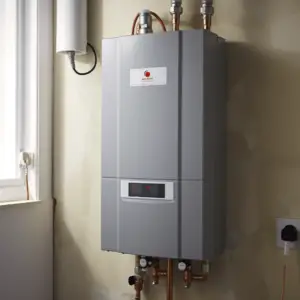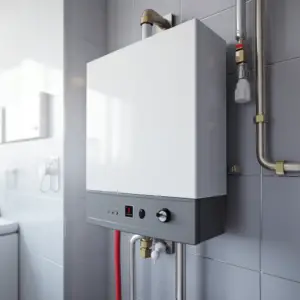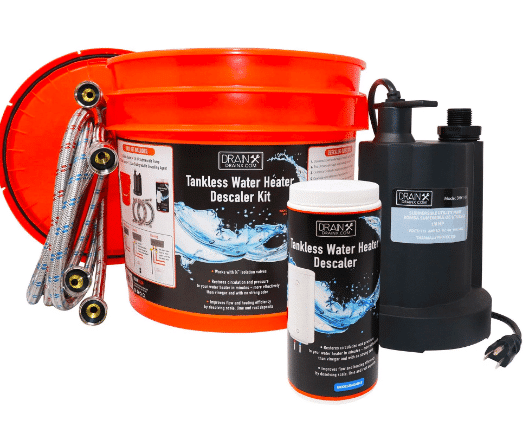If you’re in an area known for hard water, you must be familiar with “flushing.” You need to regularly descale your tankless water heater to get rid of scaling buildup to function properly.
Some modern water heaters do reach a limit where they require descaling. Therefore, they will send you an alert to your phone or display an error code on the LED that there is a maintenance issue.
There are various ways of descaling, but in this piece, we will look at two options- Vinegar and Descaler.
Table of Contents
Why Does a Tankless Water Heater Need Descaling?

Scale accumulates inside your tankless water heater slower than in the tank, with calcium buildup getting in the way of how the heater functions resulting in the heat elements becoming ineffective.
The buildup causes your heater to absorb more and more energy to get your water up to temperature, which translates to an increase in your bills over time.
Long periods without maintenance, the buildup can limit the water flow. As a result, you receive less hot water than the standard.
The scaling may erode your tankless water heater to the extent of being replaced.
Tankless Water Heater Descaler vs Vinegar
Descaling solution and undiluted white vinegar are recommended to flush the tankless water heater. People have different opinions concerning the use of these two. Both have the same process when flushing the tankless water heater but with noticeable differences.
Vinegar is affordable and has a larger quantity than a descaling kit, making it the best option for everyone. On the other hand, the descaler product is expensive, but it is worth the price because you can utilize it in small quantities.
Descale kit also comes with a tankless water heater descaling pump and hoses that attach directly to the isolation valves or water inlet, which means when you look at long-term use, it is cost-effective.
When you work with the vinegar solution, it will consume more time to be effective compared to the descaler solution, which takes less time and is highly effective.
Therefore, deciding which one to go for depends on money, how often you clean your tankless tank, and your area of residence. Overall it all comes down to your money and time.
How to Descale Your Tankless Water Heater
Servicing your tankless water heater yourself is not complex, and the results go a long way as it ensures the tank’s longevity and improves its efficiency. The procedure of flushing your tankless heater might vary slightly depending on the model. However, here is the standard procedure:
Supplies
- A tankless water heater flush pump
- Rubber/ washing machine hoses to attach to the valves
- A 5-gallon water collecting bucket
- Vinegar or descaler
- A channel lock wrench
Step By Step Process Of Flushing Your Tankless Water Heater
Before you start, set your temperatures to 150 degrees F and allow the hot water to run through the heater for about a minute.
Shut off all the power to the water heater
Close the incoming and outgoing water isolation valves to avoid interrupting the descaling process. If your unit doesn’t have an isolation valve, you can buy and install them.
With a bucket ready to collect the draining water
Drain the unit and connect hoses to the drain ports of the isolation valves “A” and “B.”
Dump the bucket or take another bucket ready to go with a mixture of both vinegar and water (add water in the bucket and the vinegar to it, then mix it for the suitable time for it to blend entirely) or descaling solution (Fill in an empty bucket with a mix of descaling solution and water). About half of the bucket will do the magic.
Whatever solution you choose will be okay as they work the same. Fill the solution in the heater and start pumping the water as it circulates. Open the isolation valves A and B. Turn on the circulation pump. Let the mixture circulate in the tankless water heater for a minimum of 30 minutes to an hour.
Drain the descaling solution from the heater and flush it with fresh water through the heater by closing valve “B.” Open up valve “A” with a hose leading to an empty bucket. Open up the inlet water valve to let freshwater flow through the unit and empty it into the empty bucket to extract all the solution from the heat exchanger.
How Often Do You Need To Descale Your Tankless Heater?

Answer this particular question depends on a few elements. You don’t need to do it often if you live where the water is soft. Checking out periodically and flushing only when it needs servicing or once a year is ideal for maintenance. On the contrary, hard water causes scaling, the number one reason you must flush your tankless water heater twice a year using the methods discussed in our earlier sections of this piece.
What Should My Tankless Water Heater Size Be?
A tankless water heater has many benefits over a tank-style counterpart. It offers a seamless and endless flow of water while using minimal electricity. Also, it has lower maintenance costs and is durable. Its warranty is also higher; most importantly, it occupies less space.
Here is what will help you choose the best size for your home:
- The size of the house
- Water flow rate
- Temperature changes rates
What Are The Downsides Of A Tankless Water Heater?
- It takes time to deliver hot water.
- Inconsistency temperatures when using multiple showers and appliances
- No power, no hot water
What Does A Tankless Water Heater Flush Cost?
You require this service at least once a year, and this will be around $150 to flush a tankless water heater. However, the price is not final as there are other considerations.
The Takeaway
Flushing a tankless water heater is pretty simple, although it may initially seem tough. Or the process to be effective, you need a set of supplies such as the descaling kit/ vinegar. All you need is to follow the guidelines, and your tank will be clean and up to the task.


